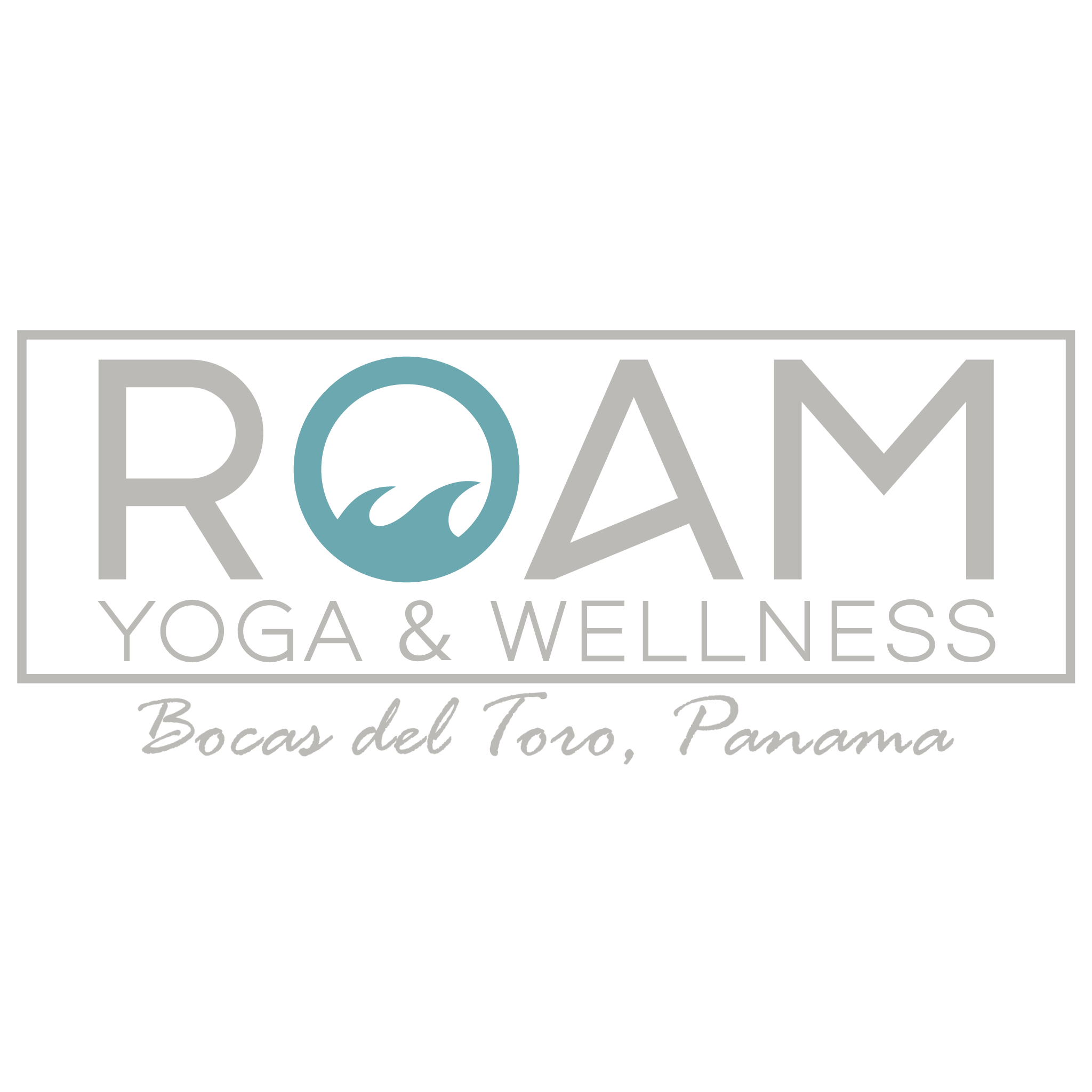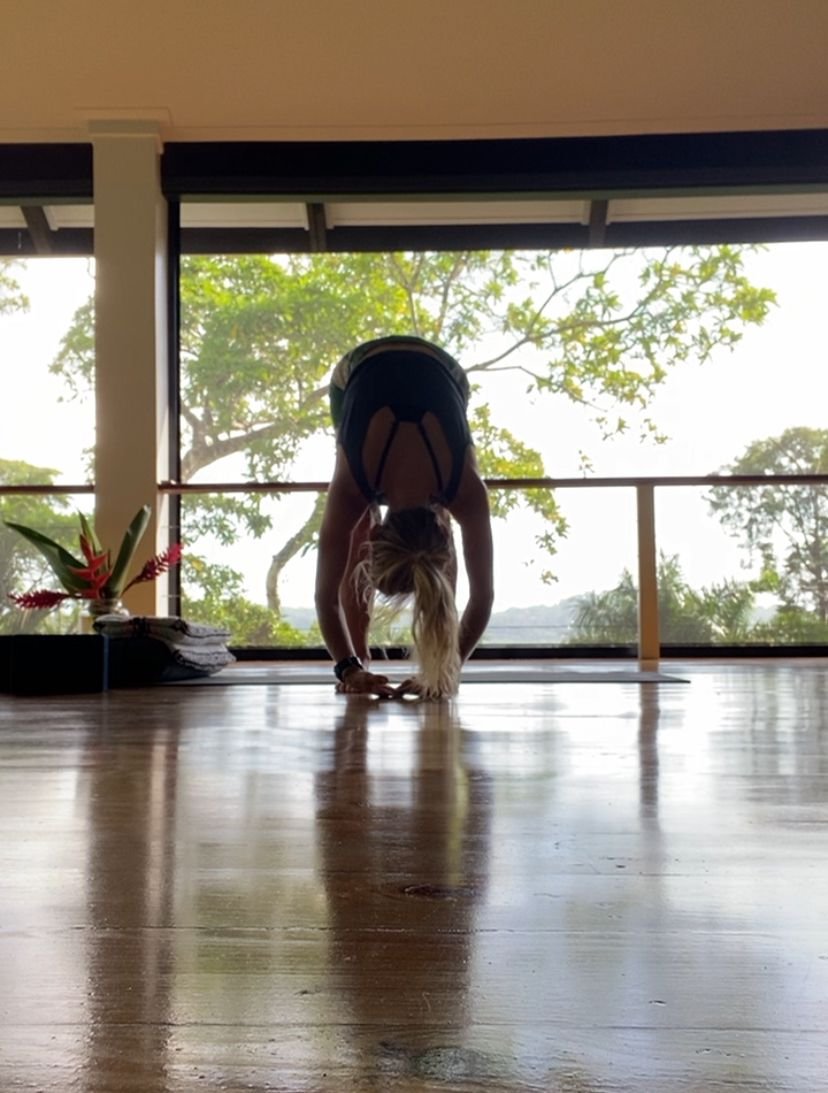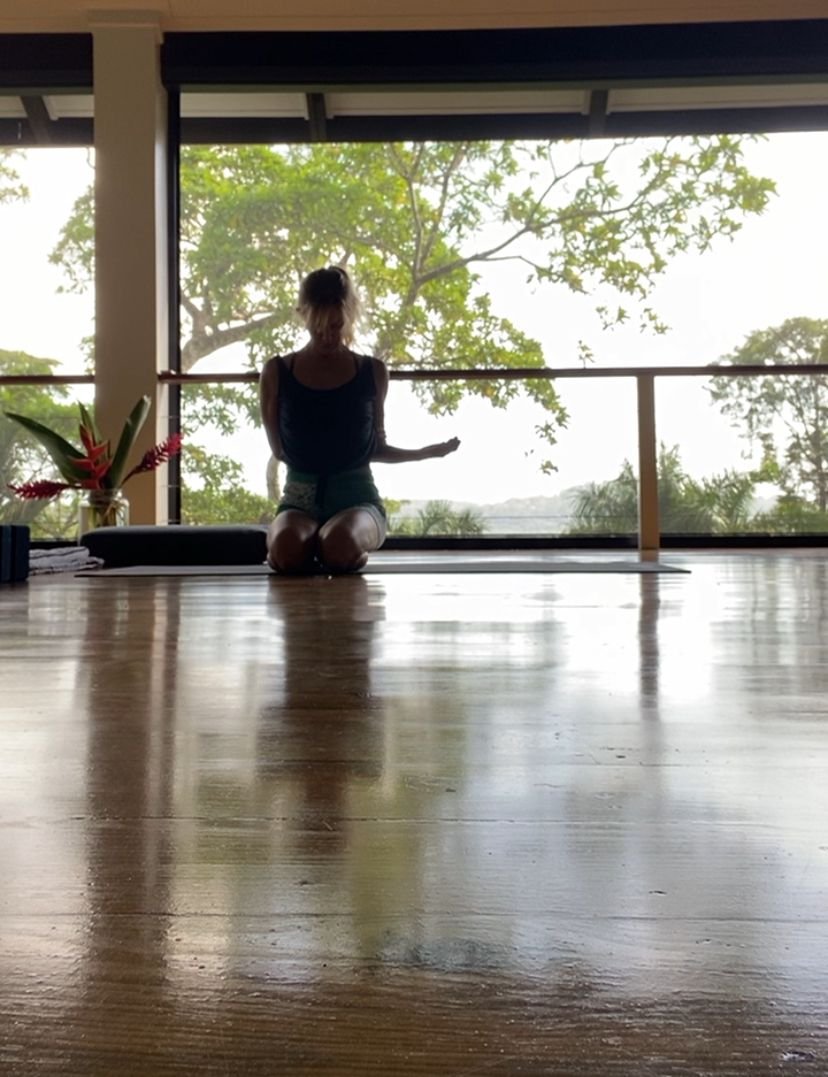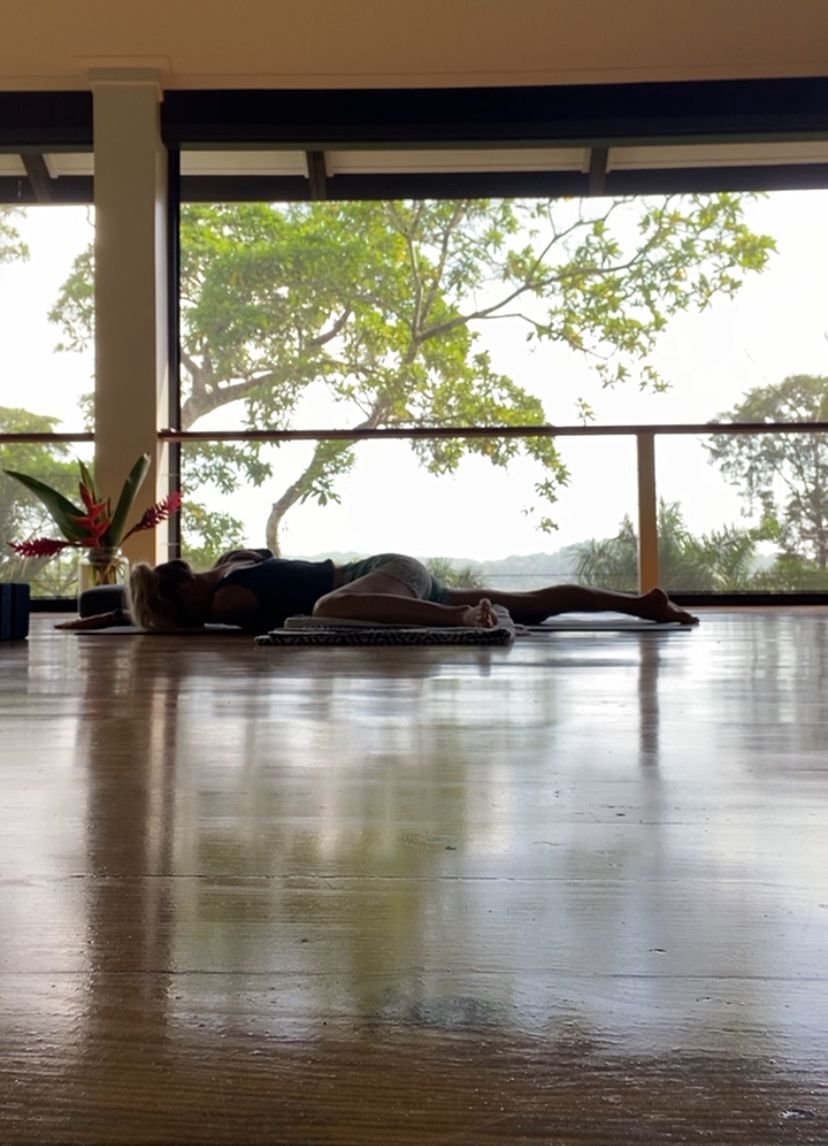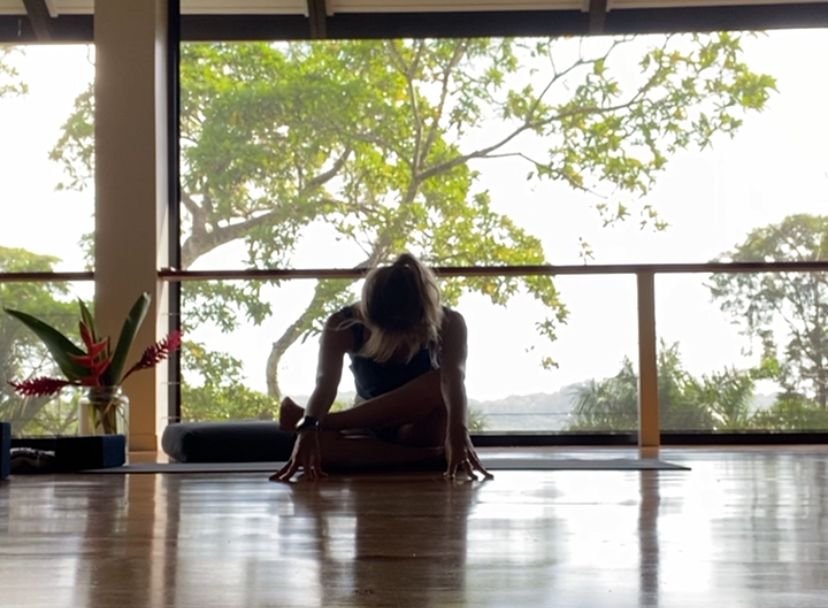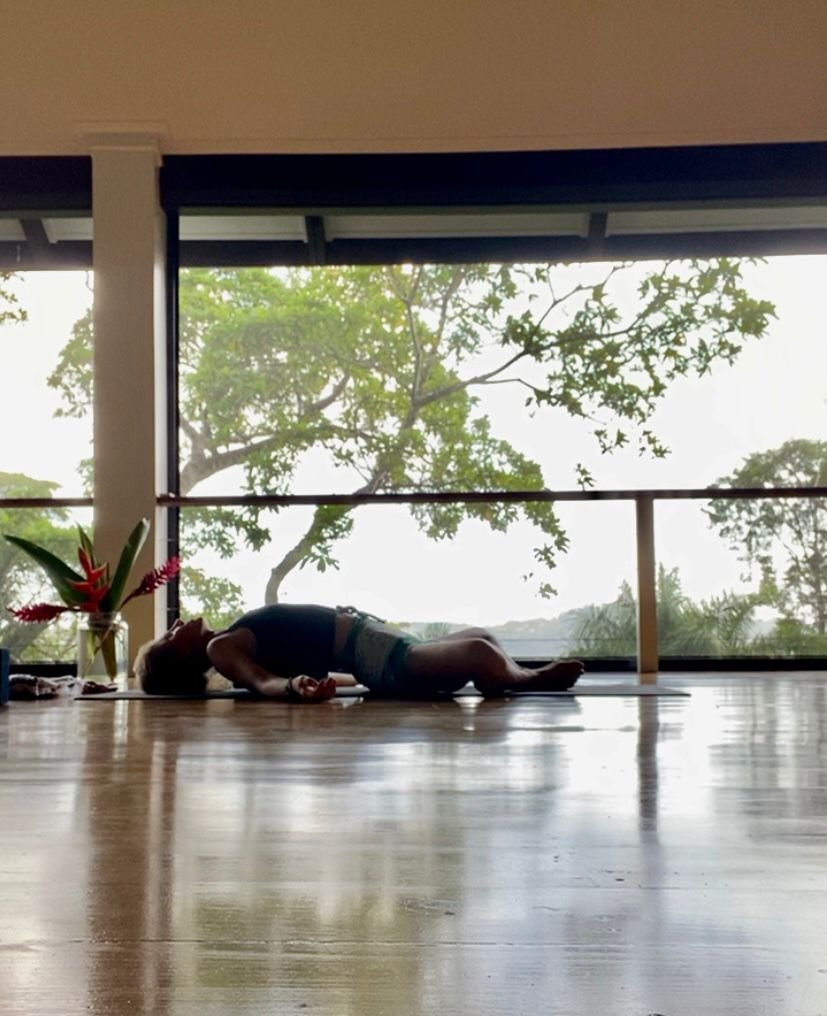Post Travel Go-To Yin Yoga Yoga Sequence
When in Bocas you are always post travel. Whether you just flew in, hopped off the bus, or got out of your boat, your body is seeking stillness on the mat. The intention of this sequence is to move the body just enough to relax the nervous system. Our hope is that, later in the evening when you are ready to sleep, your body is able to find rest , and your mind is calm enough to let you do so. To facilitate this ease of body and mind
we will target poses which help relax your parasympathetic nervous system, specifically the vagus nerve.
Post Travel Go To Yin Yoga Sequence
1. Dangling (held 3 minutes)
The primary reason here is to get upside down. To allow blood to flow in the opposite direction, to allow the body to soften both physically and figuratively, letting go of the day, the movement, and any stress therein.
How to:
Stand tall at the top of our mat. Bend the knees generously. Take a deep inhale. As you exhale, curl the chin into the chest and slowly begin to roll forward until you are in a passive standing forward fold.
Variation:
You may choose to clasp opposite elbows, interlace the hands behind the head and drag the fingers down for a bit of traction on the neck or place both hands on yoga blocks for support
Props:
This pose can be done leaning on a table top, with the back against the wall, or placing hands on a chair. The idea is to relax the head and neck with the head below the heart.
2. Child’s Pose ( held 5 min)
This pose helps to stretch the hips, thighs, and ankles, which can all become tight after long periods of travel. This can also help calm the mind and relieve stress through pratyahara or sense withdrawal.
To come into child's pose sit or kneel on a blanket on your mat. You might choose to put a yoga bolster pillow under your knees or lengthwise under the body if you have one of those props available for trunk support. Take an inhale breath to grow long through the spine. Exhale to fold forward bringing the hips towards the heels and the forehead towards the earth.
Variation:
If child’s pose is unavailable sit on the heels, let the palms relax and come to your breath
Props:
Placing a bolster or blanket underneath the body. You might also like support under the head
Pranayama:
Circular breath. As a way to find a deep sense of calm, imagine the inhale breath arising from the earth lifting from the pit of your belly, expanding the low ribs, the upper chest and rising all the way to the crown..
Notice the exhale beginning at the crown of the head and flowing down and out the back of the body from the crown, spilling over the shoulders, sliding down the back ribs, and releasing over the low back and thighs. Envision your breath flowing like a circle as you hold child’s pose.
To Release:
Walk the hands back in towards the body and find a long neutral spine. Shake out the legs, knees, and ankles. You might consider lifting into a downward facing dog to stretch out the calves and shift perspective once again. You might be surprised how tight the calves are especially if you have been flying.
3. Thread the Needle Pose ( held 5 min per side )
This pose targets the shoulders and upper back areas which can be stiff from carrying luggage, sitting for long periods of time, and are parts of many human bodies which naturally accumulate stress.
How to :
Come to all fours. Reach your left arm out to the side like a wing and take a long deep inhale. On the exhale reach the left arm under the right, as you do land the left ear on the floor. Draw the right hip back in space and think of creating a long line from the right hip to the right armpit. You might even choose to walk your right fingertips more towards the upper left corner of your mat. Breath in a way that softens the shoulders and creates space on both the front and back body.
Variation:
You might wrap the right arm around your back if you have low blood pressure and your hand falls asleep.
Props:
It can feel good to place a blanket under the feet and knees for softness and support.
4. Seated Neck stretch. ( 3 min per side )
This pose targets the cervical spine, shoulder, rhomboids.
How to: Come to a comfortable seat on your heels or a block. Hold the right arm close to the right side, elbow close to the ribs, palm facing up. Reach your left hand around your back and grab hold of the right arm at the crook of the elbow. Inhale fully, and as you exhale, allow the right ear to fall towards the right shoulder. Relax the left shoulder as well, creating more space on the left side of your cervical spine. Allow the head to move a little left and right further stimulating the vagus nerve and softening the neck and shoulders. Repeat on the Left side
Variation:
Using a strap to help reach the elbow if one cannot fully reach around the back.
Props:
Sitting tall on a block, blanket, or bolster for comfort.
5. Half Frog pose ( 5 min per side )
This pose targets the hips and abdomen. Let the belly softly press into the floor as you breathe.
How to :
Lay on the mat or blanket. Fold a blanket in half and take it to the left side of your yoga mat on the floor. Bend your left knee 90 and slide it into “frog” position on the blanket. Either make a pillow of your hands and bring your head to your hands or the floor.
Variation:
1. Start with the upper body in sphinx , softly turning the head from side to side to activate the vagus nerve. 2. Press firmly into the right palm lifting the right forearm to slide the left arm directly underneath head facing straight down to bring more weight onto the head of the shoulder to provide a deeper shoulder opening.
Props:
If in a sphinx block under head. Additional blankets under the pelvis or hips.
6. Sleeping Swan: ( 5 min per side )
This pose targets opening the hips, allowing gravity to do the work. Strong external rotation of front hip. It also provides the quadriceps and hip flexors a nice stretch for the side that has the leg back.
How to :
You can come into this pose either from Down Dog (which is more advanced) or from Cat pose (on hands and knees). Slide your right knee between your hands, lean a bit to the right, and check in with how your right knee is going to feel. If the knee is fine, flex the right foot and move it forward; if the knee feels stressed, bring the foot closer in toward the right hip. Now, center yourself so your weight is even. Try tucking the back toes under and sliding the back knee away. Do this a few times until your right buttock is on the floor or as low as it is going to get.
Variations :
To protect the front knee, keep the foot flexed before coming forward.. Stay on the hands with the arms straight, or come on to the elbows.
One could lie on a bolster placed lengthwise under the chest or between the legs to help balance the extended leg.
Other alternatives include Eye-of-the-Needle (can be done lying down, while sitting, or with one leg against the wall), Shoelace, or Square Pose.
Props:
Props in this pose are a myriad of possibilities. I love a block or blanket under my head and a bolster lengthwise under my chest and pelvis. A blanket or two under the hip of the bent leg is also highly beneficial.
7. Fire Log or Square Pose ( 5 min per side )
This pose focuses on a deep opening of the hips through strong external rotation. It also decompresses the lower back when folding forward which is fantastic post travel. Hips often feel tight, bound, and uncomfortable after a trip of any length.
How to :
Arriving in stillness in this pose can be challenging. The idea is to go where you feel some juiciness in the outer hips and not in the knees. Start by sitting with legs crossed. Move your feet forward until your shins are parallel to the front edge of your mat. Cross the right ankle on top of the left flexing both feet.
Variations:
Folding forward stretches the lower back and can intensify the stress in the hips. If you can’t come forward, sit on a cushion.
A deeper option is to place one ankle over the opposite knee and the other ankle under its opposite knee. Bring that foot to the floor in front of its opposite knee.
If you’re tight or experience discomfort in the knees, or if the knees are high off the floor, you can place blankets or some form of support under the knees. Other alternatives include Eye-of-the-Needle Pose, Shoelace, or Swan.
Props:
Sitting tall on a blanket or blankets, using a block in between the foot and knee. If folding forward leaning your head on a block.
8. Reclined Fish Pose ( hold 5 min)
This pose releases the neck and shoulders while providing a gentle extension which is often missing in travel, which tends to be a ton of forward gazing ( think phone, tablet, exit sign) and also thoughts of timing and the future.
How to :
Place a block horizontally on the floor and one perpendicular for your head allow your middle upper back to relax on the horizontal block and your head on the other block.
Variations.
Leg variation: Legs are either out straight with a blanket or bolster under the knees or soles of the feet together knees apart. If the extension or back bend is too much, you can rest on a bolster or couch cushion, just finding a way to create a subtle backbend you can relax into.
Props:
2 Blocks, a bolster, a blanket or two.
This pose can fade into savasana either by removing the prop from beneath the spine and straightening the legs, or simply by taking a huge exhale breath and letting go. The shape is less important for release than the gradual movement away from any focus on the physical, meditation on the breath, or even awareness of the present moment. In Savasana we step away from our body, from our earthly selves, we lie on the floor and do nothing, we simply are. Give yourself ten minutes in this liminal space if you can.
